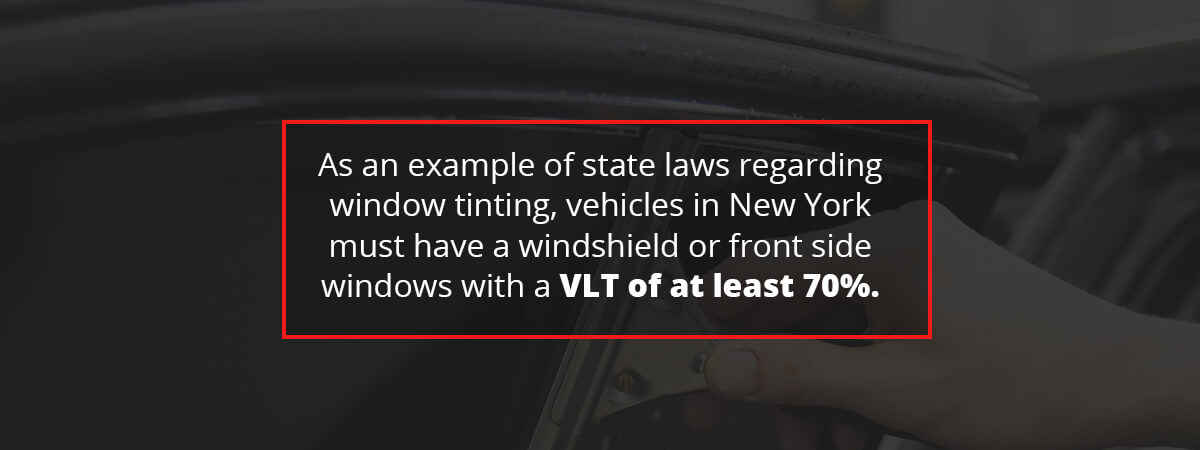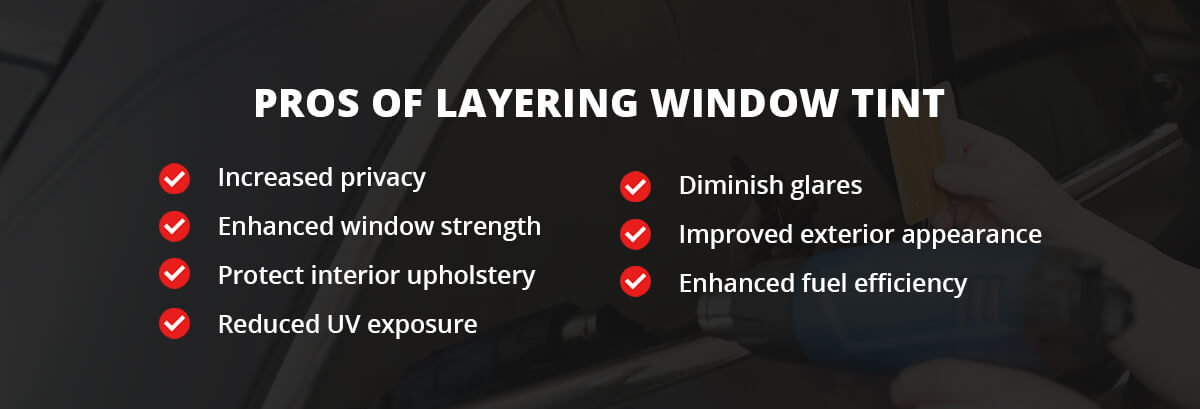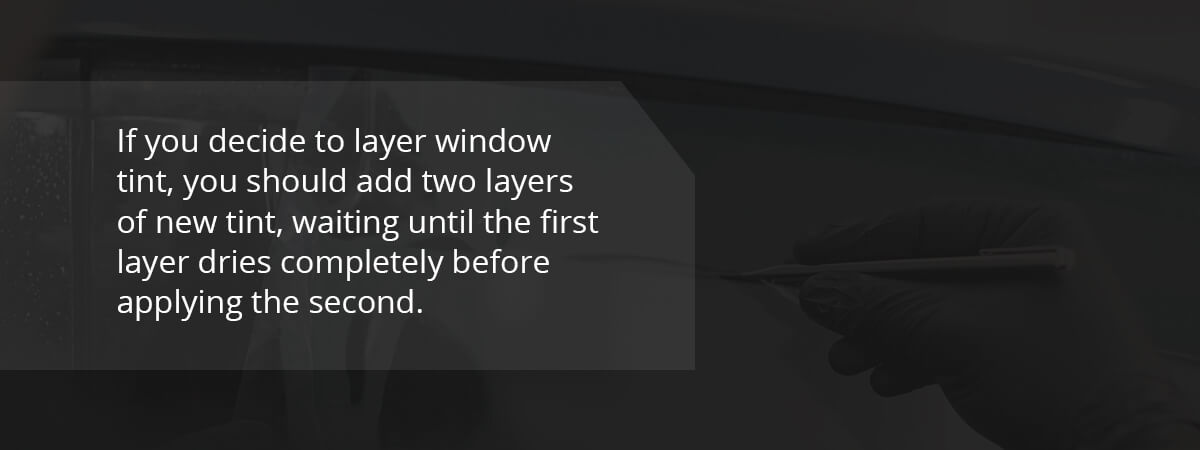
Layering Window Tint
Window tinting has practical and aesthetic benefits — it keeps the sun out of your eyes and off your skin while also giving your ride a polished appearance. It may also improve your car's resale value whenever the time comes to move on from it.
Since window tinting has such clear benefits, it may be easy to assume that layering window tints confer the same benefits, if not increase them. However, the truth is a little more complicated. We'll cover why people layer window tints, the pros and cons of doing so and options for darkening your windows.
What Is Layering Window Tint?
Layering window tint refers to applying tinting film on top of a pre-existing layer of window tinting film. In some cases, layering window tint may involve placing an aftermarket layer of window tint on factory tint. Conversely, you may want to layer two aftermarket tints on top of another. While layering window tints can have some advantages, there are several things to consider, including:
- Your goals for wanting a double-layer window tint.
- Tinting regulations in your state or local jurisdiction.
- Advantages and disadvantages of layering window tint.
- Alternatives to layering window tint.
Why Do People Layer Window Tint?
People layer window tint for several reasons. Whether you want to prevent peering passersby, reduce UV exposure or keep the sun out of your eyes, there are many valid reasons for layering window tint. Here is a list of reasons many auto enthusiasts layer their window tints:
- Increased privacy
- Upgraded window strength
- Protect interior upholstery
- Reduced UV exposure
- Diminished glares
- Improved exterior appearance
- Enhanced fuel efficiency
Can You Layer Window Tint?
In theory, yes, you can layer window tint. However, there are many things to consider before doing so. One of the most important considerations is local laws and regulations surrounding window tinting. Each state has different laws regarding how dark window tints can be. Many tint shops refuse to layer window tint. Thus, layering window tints are often DIY projects.
Visible Light Transmission
Window tinting darkness is measured according to the film's visible light transmission (VLT) percentage. Some states include film and glass in their VLT percentages, known as a Net VLT%. Other states only measure the film VLT%. VLT refers to the amount of light that passes through the window film. Higher percentages correlate with lighter tints, while lower VLT percentages imply darker tints.

As an example of state laws regarding window tinting, vehicles in New York must have a windshield or front side windows with a VLT of at least 70%. This law also applies to the rear side windows of convertibles, coupes, hardtops, hatchbacks, sedans and station wagons — grouped as passenger cars on their Federal ID label. However, there are no laws regarding the rear window VLT% of vehicles in New York, as long as left and right rear-view mirrors are present.
Oregon vehicles must have a VLT of at least 35% on windshields and front and rear side windows. New Mexico allows the darkest front-side windows at 20% VLT. As for rear side windows, Ohio, New Jersey, Nevada, Missouri, Maine, Iowa, Delaware, Colorado, California and Arizona currently allow window tints of any VLT%.
It is important to keep the VLT% in mind as you decide on layering window tint to remain within the bounds of legal permission in your state. If your factory or aftermarket tint is already at the limit of what your state allows, you will not be able to layer your window tint legally — doing so will make you vulnerable to fines from the DMV.
Other Regulations
In addition to VLT%, window tinting laws also regulate reflectivity percentages and window tint colors. The state laws regulating window tint reflectivity and color vary. Some states, such as New York, have no regulations or specifications for reflectivity and color. Other states have color restrictions on red, amber, yellow, blue, gold or black hues. As for reflectivity, regulations involve specific percentages or other stipulations, such as:
- Not excessive (NE).
- Must be non-reflective (MBNR).
- Must not increase reflectivity (MNIR).
- No metallic or mirrored appearance (NMMA).
Medical Exemptions
Besides these considerations, most states make allowances for certain medical conditions. You may be eligible for a medical exemption if you have medical conditions such as:
- Albinism.
- Chronic actinic dermatitis/actinic reticuloid (CAD/AR).
- Dermatomyositis.
- Photophobia due to an ophthalmic or neurological disorder.
- Porphyria.
- Severe drug photosensitivity, specifically for long-term medications.
- Systemic lupus erythematosus (SLE).
- Xeroderma pigmentosum (XP).
Pros and Cons of Layering Window Tint
To layer your window tint or not to layer window tint is a question not easily answered. You can increase many of the benefits of window tinting by adding layers. On the other hand, new problems manifest and risks increase when you start layering window tint. It's in your best interest to thoroughly investigate the pros and cons of layering window tints before deciding if it is the right decision. Here are some pros and cons of layering window tint to help you decide:

Pros
Some of the pros of layering window tint are enhanced versions of those for applying a tint to your window in the first place. They also align with the reasons people choose to layer window tints. Since you've read through the main reasons people choose to tint their windows already, let's expand on those reasons to explain the pros of layering your window tints:
- Increased privacy: Some people are OK with the odd ogler peering inside their vehicle to see who's behind the wheel. Others understandably feel uncomfortable when faced with staring strangers. Layered window tints keep out uninvited eyes from scanning the contents of your vehicle's interior.
- Enhanced window strength: Although tinted windows won't prevent cracks, they can help prevent shattered glass since they are applied to the inside of the window. Window tints can be helpful in accidents or if a large object strikes your car window.
- Protect interior upholstery: Unfiltered sunlight increases fading of leather and upholstered material in your vehicle. Auto owners often place a cover over the car or store it in the shade or a garage to prevent fading. Window tints can make things easier, especially if you don't have a garage at home.
- Reduced UV exposure: Various studies show the benefits of tinted windows and reduced UV exposure. As UV radiation increases your risk of skin cancer, tinted windows can effectively reduce your risk of long-term health conditions, especially if you travel a lot or have a long commute.
- Diminish glares: Whether you're driving or sitting in a passenger seat, nobody enjoys the unrelenting light of the sun directly into your eyes. Think of window tints as a pair of sunglasses for your car.
- Improved exterior appearance: Tinted windows give your ride a sleek and prestigious look. Even if the other benefits hold no currency to you, an enhanced appearance is sure to increase value.
- Enhanced fuel efficiency: Enhanced fuel efficiency is something every vehicle owner can get behind. Still, you may wonder how darker windows impact fuel efficiency. The answer is reduced reliance on air conditioning to cool your vehicle's interior as you drive on hot summer days. A/C use reduces as much as 25% of your fuel economy, so finding other ways to keep cool as you drive can keep fuel consumption from burning a hole in your pocket.
An additional benefit of getting tinting windows through Rvinyl is cost savings. If you are the DIY type or willing to get your hands dirty, you can save a significant amount of cash by ordering your tinting film through us instead of going through a detailer or tint shop.
Cons
The benefits of window tinting are pretty straightforward. Things get murkier when you get into layering window tints. Although you can further reduce UV exposure and increase other benefits of window tints through layering, those enhanced benefits come at a cost. Some disadvantages you may encounter with layering your window tints include:
- Voided manufacturer's warranty: Since window film is manufactured to be installed on glass, you void the manufacturer's warranty if you layer window tints on top of film. Doing so may lead to issues down the road if your tinting film cracks, peels or bubbles. Since factory tints are embedded within the glass, the manufacturer's warranty usually remains valid when placing aftermarket film on top of a factory tint.
- Window seal damage: Stacking window films on top of each other traps heat inside the window, which may raise glass temperatures past the manufacturer's recommended limits. When the glass becomes too warm, it can damage the window seals and even cause glass breakage.
- May negatively affect window appearance: If you layer window film too quickly, it prevents the bottom layer from drying properly. As bubbles are part of the window film drying process, they may become a permanent fixture if you apply a layer on top before letting it dry completely. Other appearance issues with layering window film include increased dirt and film edge visibility. Since tint takes a while to dry completely, it's challenging to keep the film free from dirt before installing the next layer.
- Shortened window tint life expectancy: Part of the reason manufacturer's warranty is usually voided when you install film on top of another film is that it reduces the film's life expectancy and increases the risk of damage during installation. As window film is meant to bind with glass, not film, the glue breaks down faster when you layer window tint.
- Reduced visibility: In some cases, reduced visibility may lead to safety issues as you operate your vehicle. In addition to avoiding fines, keeping your window tint percentage per local laws keeps you safe.
Can You Tint Over Old Tint?
Technically, you can layer new tint over old tint. We do not recommend it. Depending on how old the tint is, it may be inferior to the newer tint. Window tint film has advanced technologically over the years, and the new tinting film may not mingle well with the old tint.
Another reason not to apply new tint over old tint is that the new layer of tint will be subject to the older layer's decreased lifespan. The older tint may have dirt-stained into it, which will become more visible as you add a new layer.
With that in mind, it is a better idea to remove the old layer of tint before adding the new layer of tinting film. The new layer will bind to a fresh surface for optimal appearance, longevity and performance.
How Long Should You Wait Before Layering Tint?

If you decide to layer window tint, you should add two layers of new tint, waiting until the first layer dries completely before applying the second. The time it takes for window tint film to dry, or cure, depends on several factors, such as:
- Amount of sunlight the window receives
- Humidity
- Precipitation
- Temperature
Generally, it takes less time for a window tint to cure in warm, dry and sunny weather. The window tint film should cure within a few days in such conditions. In cold, wet regions with minimal sunlight, it can take a month or more for the tint film to dry thoroughly.
Alternative to Layering Window Tint
Since the best practice with layering window tint is installing two new tint films, you can save time and potentially money by buying one darker window tint film. Unless you recently installed a new film and decided it wasn't dark enough, we recommend you go with one darker film instead of applying a new tint over the old tint or installing two new tints on your car windows.
At Rvinyl, we offer window tint films as dark as 5% VLT and as light as 50% VLT and every shade in between. As you consider your window tint options, find out the specific VLT% you want for your car windows and purchase one layer of film to apply with that VLT%.

Tint Your Windows With Rvinyl Tints
Tinting your windows with Rvinyl tints offers many benefits, especially if you are inclined to DIY and restyling projects on your vehicle. We provide the perfect combination of style and affordability for your DIY tinting project, along with attractive incentives like a three-year warranty against cracking, peeling and fading and a rebate program when you send us photos of our products in action.
Browse our diverse selection of window tints today!